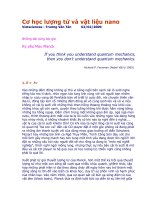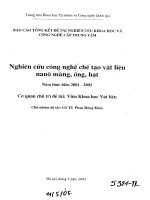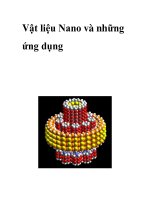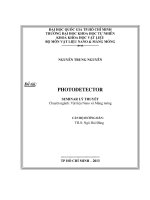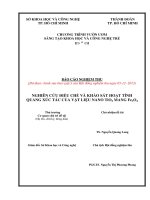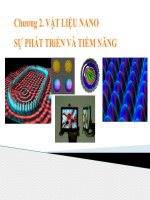Vật liệu nano và màng mỏng seeback, thốmn effect
Bạn đang xem bản rút gọn của tài liệu. Xem và tải ngay bản đầy đủ của tài liệu tại đây (284.58 KB, 18 trang )
.c
om
ng
Seebeck effect, Peltier effect and Thomson effect
co
Thermoelectric effect
th
an
Thermoelectric materials
ng
Figure of merit
cu
u
du
o
Principle, construction and working of
Thermoelectric generator
CuuDuongThanCong.com
/>
Seebeck, Peltier and Thomson effect
.c
om
Seebeck effect
an
co
ng
When the junctions of
two different metals are maintained
at different
temperature, the emf is produced in the circuit.
This is known as Seebeck effect.
cu
u
du
o
ng
th
The conductor 1 is maintained at T+∆T
temperature
CuuDuongThanCong.com
The conductor 2 is maintained at
temperature ‘T’.
Since the junctions are maintained at
different temperature, the emf ‘U’ flows
across the circuit.
/>
.c
om
ng
co
an
th
ng
du
o
u
cu
CuuDuongThanCong.com
/>
.c
om
Peltier effect
an
co
ng
Whenever current passes through the circuit of two dissimilar
conductors, depending on the current direction, either heat is
absorbed or released at the junction of the two conductors.
This is known as Peltier effect.
cu
u
du
o
ng
th
absorbed
released
CuuDuongThanCong.com
/>
.c
om
ng
co
an
th
ng
du
o
u
cu
CuuDuongThanCong.com
/>
.c
om
Thomson effect
ng
du
o
Thermoelectric effect
th
an
co
ng
Heat is absorbed or produced when current flows in material
with a certain temperature gradient. The heat is proportional to
both the electric current and the temperature gradient. This is
known as Thomson effect.
cu
u
The thermoelectric effect, is the direct conversion of heat
differentials to electric voltage and vice versa..
CuuDuongThanCong.com
/>
.c
om
Thermoelectric materials
•
ng
The good thermoelectric materials should possess
th
an
co
1. Large Seebeck coefficients
2. High electrical conductivity
3. Low thermal conductivity
BismuthTelluride (Bi2Te3),
Lead Telluride (PbTe),
SiliconGermanium (SiGe),
Bismuth-Antimony (Bi-Sb)
u
•
•
•
•
du
o
ng
The example for thermoelectric materials
cu
•
CuuDuongThanCong.com
/>
.c
om
Figure of merit
cu
u
du
o
ng
th
an
co
ng
A high electrical conductivity is necessary to minimize Joule
heating and low thermal conductivity helps to retain heat at the
junctions and maintain a large temperature gradient. These
three properties were later put together and it is called figureof-merit (Z).
CuuDuongThanCong.com
/>
ng
Heat input
co
Thermoelectric power generator
based on the principle of
Seebeck effect that when the
junctions of two different metals
are maintained at different
temperature,
the
emf
is
produced in the circuit
.c
om
Principle, construction and working of
Thermoelectric power generator
P-type
N-type
du
o
ng
th
an
Hot junction
cu
u
Cold junction
CuuDuongThanCong.com
Heat ejection
Power output
/>
• In order to select materials and design a thermoelectric
.c
om
generator, one needs to start with a general understanding of the
thermoelectric effects.
co
ng
• In a thermoelectric material there are free carriers which carry
both charge and heat.
an
• Perhaps the simplest example is a gas of charged particles.
du
o
ng
th
• If a gas is placed in a box within a temperature gradient, where
one side is cold and the other is hot, the gas molecules at the
hot end will move faster than those at the cold end.
cu
u
• The faster hot molecules will diffuse further than the cold
molecules and so there will be a net build up of molecules
(higher density) at the cold end.
• The density gradient will cause the molecules to diffuse back to
the hot end.
CuuDuongThanCong.com
/>
.c
om
• In the steady state, the effect of the density gradient will exactly
counteract the effect of the temperature gradient so there is no net
flow of molecules.
Diagram shows
The charge buildup at cold side
cu
u
du
o
ng
th
an
co
ng
• If the molecules are charged, the buildup of charge at the cold
end will also produce a repulsive electrostatic force (and therefore
electric potential) to push the charges back to the hot end.
CuuDuongThanCong.com
/>
.c
om
The electric potential produced by a temperature
difference is known as the Seebeck effect and the
proportionality constant is called the
Seebeck
coefficient.
•
If the free charges are positive (the material is p-type),
positive charge will build up on the cold which will
have a
positive potential.
•
Similarly, negative free charges (n-type material) will
produce a negative potential at the cold end.
cu
u
du
o
ng
th
an
co
ng
•
CuuDuongThanCong.com
/>
Construction
co
ng
.c
om
Thermoelectric power generation (TEG) devices typically use
special semiconductor materials, which are optimized for the
Seebeck effect.
du
o
ng
th
an
The simplest thermoelectric power generator consists of a
thermocouple, comprising a p-type and n-type material
connected electrically in series and thermally in parallel.
cu
u
Heat is applied into one side of the couple and rejected from the
opposite side.
An electrical current is produced, proportional to
temperature gradient between the hot and cold junctions.
CuuDuongThanCong.com
/>
the
co
an
th
ng
du
o
u
•
•
Heat source (fuel)
P and N type
semiconductor stack
(TE module)
Heat sink (cold side)
Electrical load
(output voltage)
cu
•
•
ng
.c
om
Therefore, for any TEPG, there are four basic component required
such as
CuuDuongThanCong.com
/>
.c
om
• The figure shows the construction of thermoelectric
power generator.
co
ng
• There is a burner in which the propane fuel is used as
heating source in one side.
an
• The exhaust is used to transmit a burnt fuel.
ng
th
• On the other side, a cold junction is kept.
cu
u
du
o
• The thermoelectric module (TE) (consist of number of
P- type and N-type semiconductor pellets connected in
series or parallel depending on the served load)) is kept in
between the hot and cold junction.
• The electrical out (load) is taken from the TE module.
CuuDuongThanCong.com
/>
.c
om
Working
co
ng
When the two sides of semiconductor are maintained with
different temperature, the emf is flows across the output
circuit
an
N-type
Hot side
cu
u
du
o
ng
th
Cold side
Heat flow
V
Electron flow
CuuDuongThanCong.com
/>
.c
om
• As the heat moves from hot side to cold side, the charge
carrier moves in the semiconductor materials and hence
the potential deference is created.
th
an
co
ng
• The electrons are the charge carriers in the case of Ntype
semiconductor
and
Hole
are
in
P-type
semiconductors.
P-type
and
N-type
du
o
ng
• In
a
stack,
number
of
semiconductors is connected.
cu
u
• A single PN connection can produce a Seebeck voltage
of 40 mV.
• The heat source such as natural gas or propane are
used for remote power generation
CuuDuongThanCong.com
/>
.c
om
Advantages
Easy maintenance: They works electrically without any
are virtually maintenance free.
produce
no
pollution.
an
co
ng
Environment friendly: Thermoelectric generators
Therefore they are eco friendly
generators.
moving parts so they
system
is
ng
th
Compact and less weight: The overall thermoelectric
cooling
much smaller and lighter than a
comparable mechanical system.
high reliability due to
du
o
High Reliability: Thermoelectric modules exhibit very
their solid-state construction
cu
u
No noise: They can be used in any orientation and in zero
Thus they are popular in many aerospace applications.
Convenient Power Supply: They operate directly
CuuDuongThanCong.com
gravity
environments.
from a DC power source.
/>

